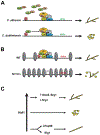Regulatory mechanisms controlling morphology and pathogenesis in Candida albicans
- PMID: 31129557
- PMCID: PMC6874724
- DOI: 10.1016/j.mib.2019.04.005
Regulatory mechanisms controlling morphology and pathogenesis in Candida albicans
Abstract
Candida albicans, a major human fungal pathogen, can cause a wide variety of both mucosal and systemic infections, particularly in immunocompromised individuals. Multiple lines of evidence suggest a strong association between virulence and the ability of C. albicans to undergo a reversible morphological transition from yeast to filamentous cells in response to host environmental cues. Most previous studies on mechanisms important for controlling the C. albicans morphological transition have focused on signaling pathways and sequence-specific transcription factors. However, in recent years a variety of novel mechanisms have been reported, including those involving global transcriptional regulation and translational control. A large-scale functional genomics screen has also revealed new roles in filamentation for certain key biosynthesis pathways. This review article will highlight several of these exciting recent discoveries and discuss how they are relevant to the development of novel antifungal strategies. Ultimately, components of mechanisms that control C. albicans morphogenesis and pathogenicity could potentially serve as viable antifungal targets.
Copyright © 2019 Elsevier Ltd. All rights reserved.
Conflict of interest statement
Conflict of Interest
The author declares no conflict of interest.
Figures


Similar articles
-
Temporal dynamics of Candida albicans morphogenesis and gene expression reveals distinctions between in vitro and in vivo filamentation.mSphere. 2024 Apr 23;9(4):e0011024. doi: 10.1128/msphere.00110-24. Epub 2024 Mar 19. mSphere. 2024. PMID: 38501830 Free PMC article.
-
Ppg1, a PP2A-type protein phosphatase, controls filament extension and virulence in Candida albicans.Eukaryot Cell. 2014 Dec;13(12):1538-47. doi: 10.1128/EC.00199-14. Epub 2014 Oct 17. Eukaryot Cell. 2014. PMID: 25326520 Free PMC article.
-
Control of Candida albicans morphology and pathogenicity by post-transcriptional mechanisms.Cell Mol Life Sci. 2016 Nov;73(22):4265-4278. doi: 10.1007/s00018-016-2294-y. Epub 2016 Jun 16. Cell Mol Life Sci. 2016. PMID: 27312239 Free PMC article. Review.
-
The spliceosome impacts morphogenesis in the human fungal pathogen Candida albicans.mBio. 2024 Aug 14;15(8):e0153524. doi: 10.1128/mbio.01535-24. Epub 2024 Jul 9. mBio. 2024. PMID: 38980041 Free PMC article.
-
Growth of Candida albicans hyphae.Nat Rev Microbiol. 2011 Aug 16;9(10):737-48. doi: 10.1038/nrmicro2636. Nat Rev Microbiol. 2011. PMID: 21844880 Review.
Cited by
-
Lectins ConA and ConM extracted from Canavalia ensiformis (L.) DC and Canavalia rosea (Sw.) DC inhibit planktonic Candida albicans and Candida tropicalis.Arch Microbiol. 2022 May 24;204(6):346. doi: 10.1007/s00203-022-02959-x. Arch Microbiol. 2022. PMID: 35608680 Free PMC article.
-
Transcriptional regulation of the synthesis and secretion of farnesol in the fungus Candida albicans: examination of the Homann transcription regulator knockout collection.G3 (Bethesda). 2023 Sep 30;13(10):jkad172. doi: 10.1093/g3journal/jkad172. G3 (Bethesda). 2023. PMID: 37522561 Free PMC article.
-
Small molecules restore azole activity against drug-tolerant and drug-resistant Candida isolates.mBio. 2023 Aug 31;14(4):e0047923. doi: 10.1128/mbio.00479-23. Epub 2023 Jun 16. mBio. 2023. PMID: 37326546 Free PMC article.
-
Myricetin Exerts Antibiofilm Effects on Candida albicans by Targeting the RAS1/cAMP/EFG1 Pathway and Disruption of the Hyphal Network.J Fungi (Basel). 2025 May 21;11(5):398. doi: 10.3390/jof11050398. J Fungi (Basel). 2025. PMID: 40422732 Free PMC article.
-
N-Acetylglucosamine Regulates Morphogenesis and Virulence Pathways in Fungi.J Fungi (Basel). 2019 Dec 24;6(1):8. doi: 10.3390/jof6010008. J Fungi (Basel). 2019. PMID: 31878148 Free PMC article. Review.
References
-
- Edmond MB, Wallace SE, McClish DK, Pfaller MA, Jones RN, Wenzel RP: Nosocomial bloodstream infections in United States hospitals: a three-year analysis. Clin Infect Dis 1999, 29:239–244. - PubMed
-
- Wisplinghoff H, Bischoff T, Tallent SM, Seifert H, Wenzel RP, Edmond MB: Nosocomial bloodstream infections in US hospitals: analysis of 24,179 cases from a prospective nationwide surveillance study. Clin Infect Dis 2004, 39:309–317. - PubMed
-
- Odds FC: Candida and Candidosis edn 2nd London: Baillière Tindall; 1988.
-
- Odds FC: Pathogenesis of Candida infections. J Am Acad Dermatol 1994, 31:S2–5. - PubMed
-
- Dupont PF: Candida albicans, the opportunist. A cellular and molecular perspective. J Am Podiatr Med Assoc 1995, 85:104–115. - PubMed
Publication types
MeSH terms
Grants and funding
LinkOut - more resources
Full Text Sources

